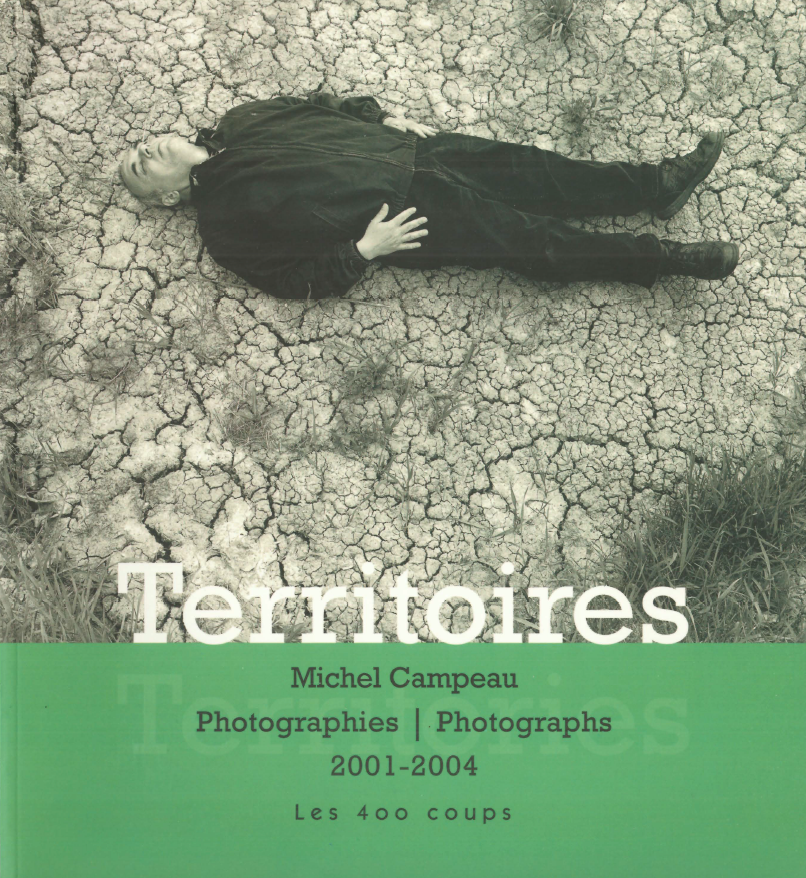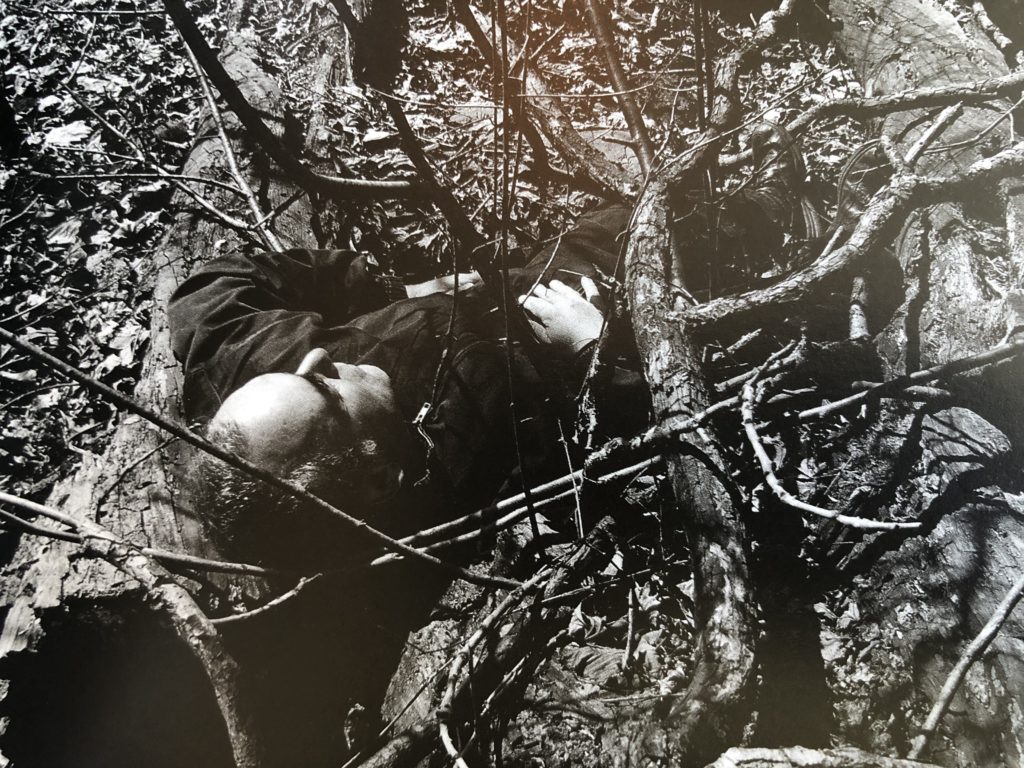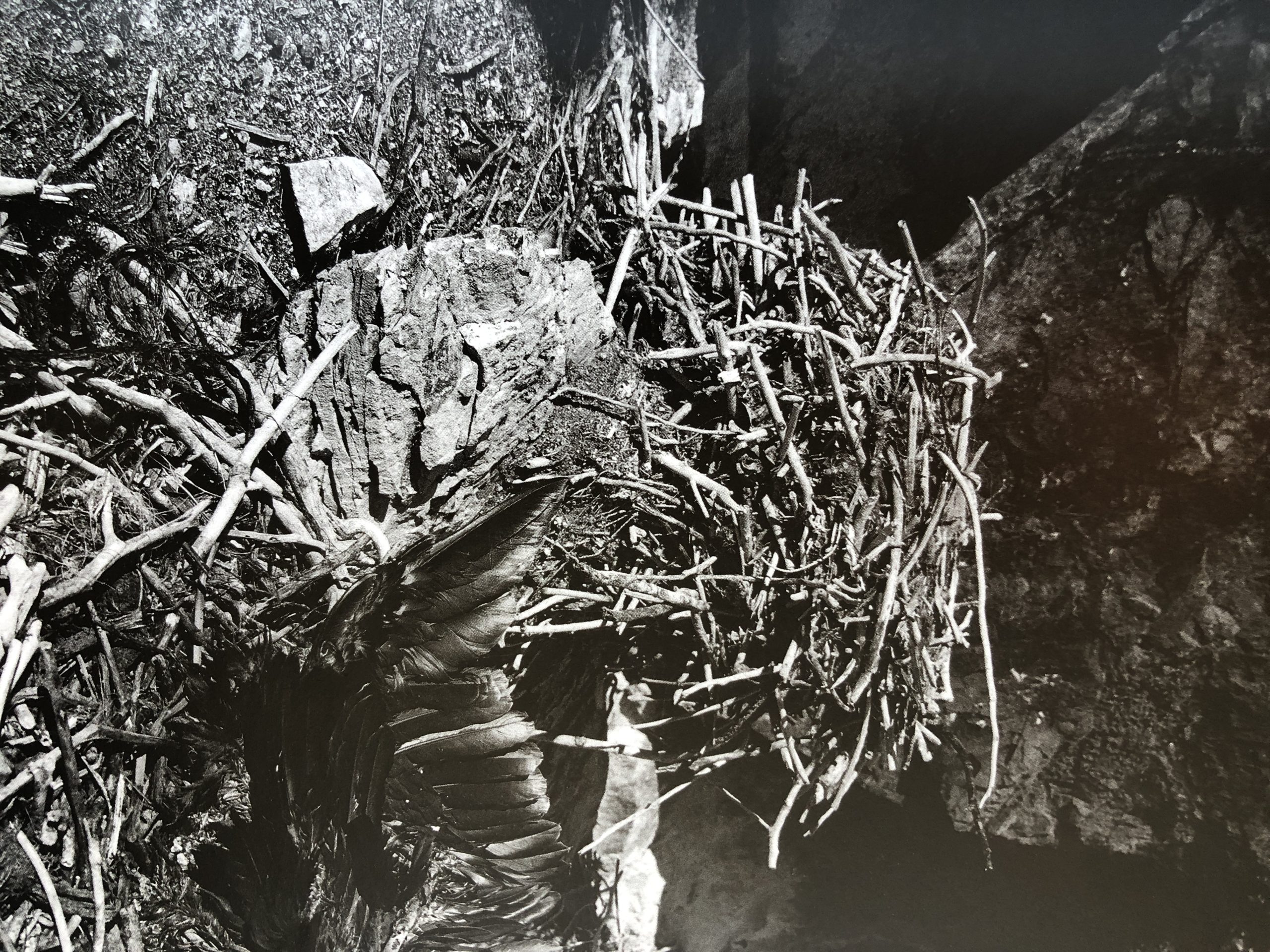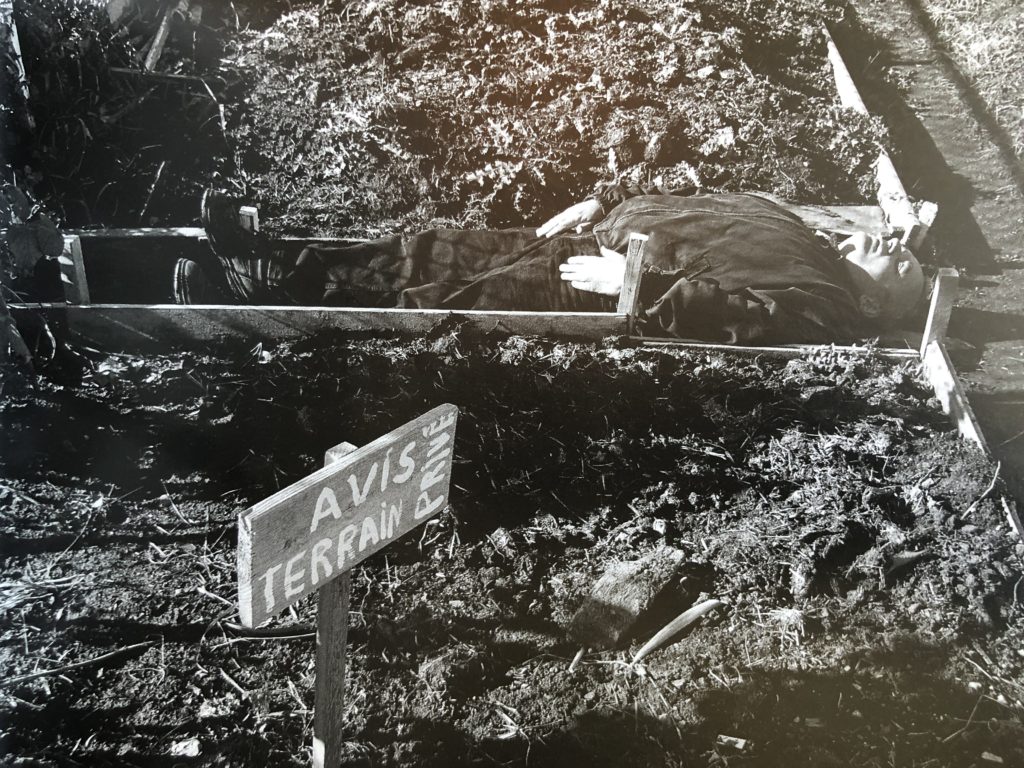Animal/Vegetable/Mineral: Michel Campeau’s Acts of Succession (2007)

Graham, Robert. (2007) Animal/Vegetable/Mineral: Michel Campeau's Acts of Succession. In Michel Campeau, Territoires et paysages métaphysiques. Éditions les 400 coups, Montréal, Quebec.Those masterful images because complete
“The Circus Animals’ Desertion,” W.B. Yeats
Grew in pure mind, but out of what began?
A mound of refuse or the sweepings of a street,
Old kettles, old bottles, and a broken can,
Old iron, old bones, old rags, that raving slut
Who keeps the till. Now that my ladder’s gone,
I must lie down where all the ladders start
In the foul rag-and-bone shop of the heart
Michel Campeau’s “Territoires” are fields where natural history meets the mythopoetic; where states of material being show their symbolic decay and transmutations; and where the resultant mutations point to renewal. Natural history is the temporal account of change in our physical environment. The constancy of nature (the laws of conservation of energy /matter) suggests that all change is a question of the interaction, transformation, and succession between states. At the chemical level, each of the states of matter can transmute into, and be relayed to, another. Chemistry can track the interaction, turns of succession, and replacement between the states of material being.

Campeau’s segmented and multifaceted work begins with a section called “Humus,” which is the terrestrial zone that he is performing on. The humic refers to the ground: not the deep geological ground of the subterranean or the territory of the chtonic, but the thin, superficial ground, that layer where eroded rocky minerals and moist, decaying vegetal matter meet and mix to produce the life-sustaining, fertile layer of regenerative soil.
In February 1858, the British art critic and polymath John Ruskin gave a public lecture in Tunbridge Wells on “The Work of Iron, in Nature, Art, and Policy.” As a geologist, he began by talking about the iron in the ground and how unattractive it can be, “and when you see rusty iron … you generally think … that rusty iron is spoiled iron.” But here he sets up a surprising opposition: “iron rusted is Living: but when pure or polished, Dead.” For Ruskin, rust (ferric oxide, Fe2O3) is the manifestation of a metal’s participation in the earth’s “circles of vitality.”
“It takes the oxygen from the atmosphere as eagerly as we do, though it uses it differently,” said Ruskin. “The iron keeps all that it gets: we, and other animals, part with it again; … the ochreous dust … is iron and the air . .. in making the ground we feed from, and nearly all the substances first needful for our existence. For these are all nothing but metals and oxygen – metals with breath put into them.”‘
As a component of its vitality, the humus is also where all that dies goes, for the sake of regeneration. In his book on the cultural processing of the dead, Robert Pogue Harrison sought to “uncover what I call the humic foundations of our life worlds. A humic foundation is one whose contents have been buried so that they may be reclaimed by the future. The humic holds in its conserving element the unfinished story of what has come to pass.”2
In “Humus,” Campeau presents himself in dark, monochromatic clothing, purposefully blending into his chosen landscapes: in a garden, a forest, atop a cairn of rocks, obscured by thick bushes and trees. Mostly, he’s lying down, in a kind of rehearsal of death. Campeau has chosen for the book’s epigraph a quotation from The Writing Life by Annie Dillard in which she suggests that the writer adopt an accelerated premortem position: “Write as if you were dying.” This prescription serves as a heuristic to overcome writerly hesitation, but it is also a philosophically advantageous abandonment of the immediate and the temporal. It takes the long, eternal view of what matters and, like deep ecology, is indifferent to any individual fate on behalf of what remains after and beyond an individual life. For natural history is a sequence of extinctions. Assuming one’s death is an ancient and worthy spiritual exercise and, according to Penny Cousineau-Levine, Canadian art photography’s favourite posture. 3 The physical and corporeal analogue of this attitudinal position is to lie down, particularly to recline on the earth. Among the medieval acts of devotion and repentance was humicubation, or lying on the ground, as a sign of penitence or humiliation.
Campeau’s persistent attention to the body in death is not morbid or distressing. He presents the fact of death as if it were as dull and uncontroversial as gravity. Yet certainly he is also placing death at the fulcrum of thought and action. The science writer Loren Eiseley states the case for the anxious human animal: “It is necessary in surveying the human quest for certainty to consider death before life … it is necessary to understand certain aspects of death before we can comprehend the nature of life and its changes.” 4 Michelangelo treated his death as his personal capital, nourishing and creative: “I live on my death,” he wrote. ”.And he who does not know how to live on anxiety and death, let him come into the fire in which I am consumed.” 5 Moreover, for Sigmund Freud, an acknowledgment of death was the primary basis of Reality: “The undersong is Freud’s moral injunction that each of us needs to accept ‘reality-testing’ by making friends with the necessity of dying,” writes Harold Bloom.6
Physically, our death makes a small contribution to the humic “circle of vitality.” “Dying is mostly evaporating,” explains Midas Dekkers. “What remains consists primarily of nitrogen and carbon, absorbed from the air for us by plants …. In the few kilograms of dust that are left, there’s enough phosphorous for 50 boxes of matches, iron for one solid-iron nail, lime for whitewashing a chicken coop, and just enough potassium for one roll of pistol caps. To bury is to create compost.”7
•••
The 20th century saw a number of thinkers whose writings include or suggest an anthropology of art, which gives artists a special social function and assigns them a unique set of tasks. Among others, Carl Jung, Sigmund Freud, Marshall McLuhan, and Claude Levi-Strauss were all thinkers who valued and honoured artists for the seriousness of their work. Not surprisingly, artists often returned the favour by citing these same figures as providing descriptive and explanatory glosses to their art.
Unlike an earlier model of art that identified the artist’s goal as one of pursuing a classical ideal, the modernist scheme was based on a destructive, repudiating, constant revolution of novelty. The past was no longer to be emulated, but to be picked over like a garbage dump. Freud compared his psychoanalytical work to archaeology, specifically to digging in the ruined archive, which he identified as an analogy for the buried memory and the repressed. Ruin or garbage heap, the sites of regeneration are identified as devalued, forgotten, overlooked, and perhaps to be ashamed ofno better than waste matter. Archaeology is not just the study of past objects, but the study of humanity’s origins, specifically humanity’s early forms and patterns, which remain as buried and forgotten memories. Archaeology is a perfect analogy for seeking out the repressed, so it is easy to consider the excavation of the unconscious as a kind of archaeological dig.
For McLuhan, the artist is an explorer and a hunter-gatherer among the refuse. ”Artists and archaeologists,” he wrote, “see a world of order and significant social gesture in any midden heap.”· The mythic task: the photographer as a forager, and then as a processor of his imaginary landscape, like a renderer who collects discarded animal fat and turns it into useful tallow.
In The Savage Mind, anthropologist Levi-Strauss identifies artistic and mythic thinking as processes of rearranging: “The characteristic feature of mythic thought is that it expresses itself by means of a heterogeneous repertoire which, even if extensive, is nevertheless limited …. Mythical thought is therefore a kind of intellectual ‘bricolage.”‘9 Against this model, he posits the scientific, goal-oriented, and innovative engineer who “questions the universe, while the ‘bricoleur’ addresses himself to a collection of oddments left over from human endeavours, that is, only a sub-set of the culture.”10
This “collection of oddments” is the artistic tradition the artist expropriates for his own use. Besides backward retrievals from the past, Campeau also performs lateral retrievals of contemporary photographers’ work: sometimes the quote is a covert similarity (Lee Friedlander’s silhouette), sometimes an overt reference by including a photo within Campeau’s picture (Dieter Appelt and others). The artist forages among the tradition, consuming and digesting the artistic past, including references to his own past work, in which he self-cannibalizes. The photographer as forager seeks out specially inhabited landscapes and places that have been devalued and discounted: sites of the marginal or discarded, such as the urban garden, graveyards, industrial dumps, islands of excrement: resonant locations of waste and possibility.

“Fientes” is the result of a visit to an island in the St. Lawrence River called le Pilier de Bois, a popular nesting site for cormorants. Besides being a massive bird colony and an “Important Bird Area,” it is also a storehouse of guano, the mature seabird excrement that makes a rich natural fertilizer. Historically, whenever mariners discovered an unknown “guano island,” they considered themselves very lucky, for back home the guano was a valuable product. Bird shit can be treasure.
In recording his visit to a dumping ground for machinery in “Savona,” Campeau is not decrying waste mismanagement – why would he when he so delights in what he finds? This is not repulsive garbage but a post-industrial graveyard, an industrial midden heap, and a psychic treasure trove, full of resonant shapes, suggestive objects, and fruitful haphazard combinations. The decay and rust serve as a transformative patina, indicative of natural processes of replacement and succession. This site is both productive and pleasing: one old device, a metal ruin, is actually named “Joy.” Following Ruskin, we note the life signature of oxidation, the humic breakdown and decay and the potential for future bricolage. The photographer finds forms that resemble other forms -visual homonyms. In the section called “Mikado,” two crossed beams have become a crucifix. Here, a machine’s housing morphs into a casket. The world becomes full of visual significance, in which the camera is an investigative tool for finding messages and personal links, correspondences with the photographer’s life.

In his new book, The Corporeal Image: Film, Ethnography and the Senses, ethnographical filmmaker David MacDougall attempts a body-centred, biological description of film and photographic encounters: “A complex construction such as a film or photograph has an animal origin. Corporeal images are not just the images of other bodies; they are also images of the body behind the camera and its relation with the world.”11 In his self-portraits, Campeau doubles his body: the acting subject body in front of the camera and the body behind the camera that positions the camera and frames the picture. The viewer’s encounter with the picture also has its biological, intuitive, and creaturely aspect. MacDougall says this immediate feeling is sudden and brief, repressed and quickly replaced with our learned and accultured response. It is presumptuous to think we have entirely shed our primitive origins, or that the far past does not continue to have ongoing effect.
If, as noted before, the artist is predatory towards tradition, he is also prepared to be self-sacrificing, for in combining with tradition he prepares for his own displacement. Quebec ecologist and “sociologist of trees” Pierre Dansereau, whose Biogeography is a study of the “origin, distribution, adaptation and association of plants and animals,” describes the dynamic evolution of forest growth as a series of replacements where the species of each era establish the conditions for their own succession. Dansereau’s second Law of Community Adjustment, or the Law of Succession, reads: “The same site will not be indefinitely held by the same plant community, because the physiographic agents and the plants themselves induce changes in the whole environment, and these allow other plants heretofore unable to invade to displace the present occupants.” 12
“Territoires,” a biological/cultural chronicle, ends with “Paysages metaphysiques,” a poetic envoi, a collection of linked ensembles of images that revisit and recapitulate what preceded. Fragments are newly arranged together to point to the future: not as preserved memories, but humic recollections ready for unpredictable transformations.
As an artist, the photographer lies down to join with memory and tradition “in the foul rag-and-bone shop of the heart,” in a pattern of recirculation and regeneration. As a human animal, he joins his ancestors and offers the return of his nutrients to the soil.
Notes
1. John Ruskin, “The Work of Iron, in Nature, Art, and Policy,” in The Two Paths (Boston: Dana Estes & Company, n.d.), pp. 104-106.
2. Robert Pogue Harrison, The Dominion of the Dead (Chicago: University of Chicago Press, 2003), p. x.
3. Penny Cousineau-Levine, Faking Death: Canadian Art Photography and the Canadian Imagination (Montreal & Kingston: McGill-Queen’s University Press, 2003).
4. Loren Eiseley, The Firmament of Time (New York: Atheneum, 1960), p. 33.
5. Adrian Stokes, Michelangelo:A Study in the Nature of Art (London: Routledge Classics, 2002), p. 104.
6. Harold Bloom, “Why Freud Matters,” in The Wall Street Journal, May 5, 2006, p. A16.
7. Midas Dekkers, The Way of All Flesh: The Romance of Ruins, trans. from the Dutch by Sherry Marx-Macdonald (New York: Farrar, Straus and Giroux, 2000), p. 187.
8. Marshall McLuhan, Culture Is Our Business (New York: McGraw-Hill, 1970), p. 312.
9. Claude Levi-Strauss, The Savage Mind (Chicago: University of Chicago Press, 1966), p. 17
10. Ibid., p. 19.
11. David MacDougall, The Corporeal Image: Film,Ethnography and the Senses (Princeton: Princeton University Press, 2006), p. 3. 12. Pierre Dansereau, Biogeography: An Ecological Perspective (New York: The Ronald Press, 1957),p . 203.